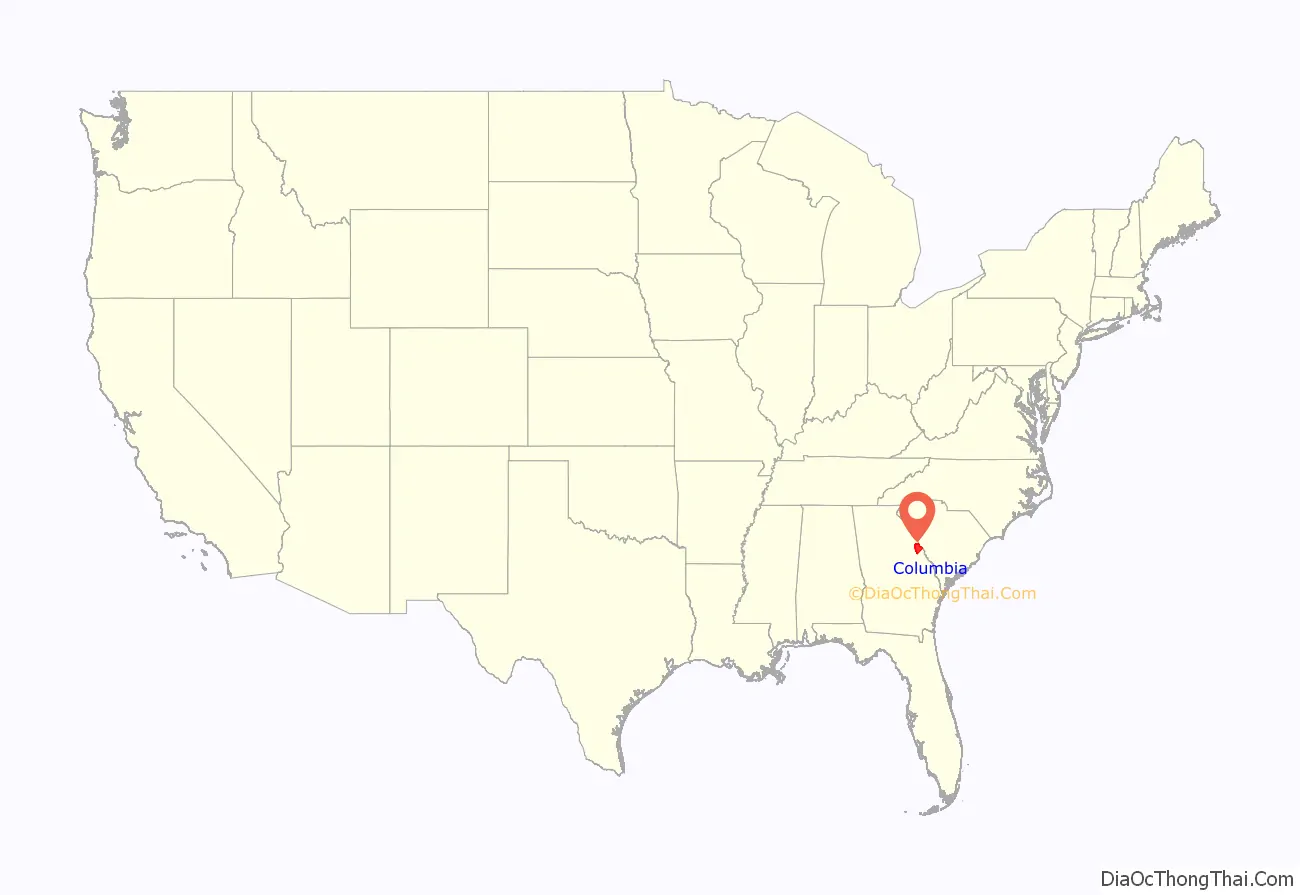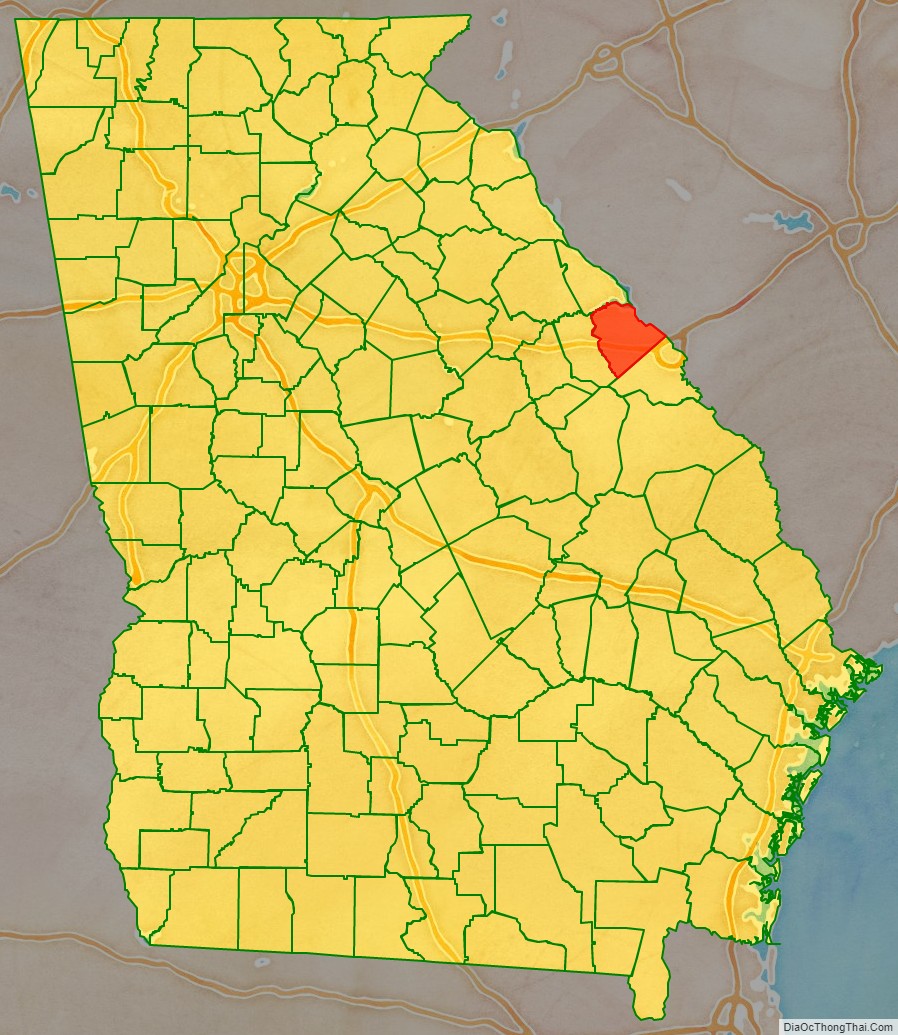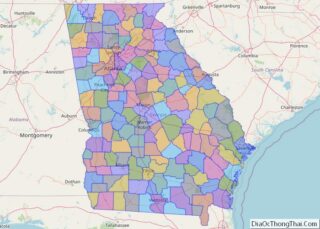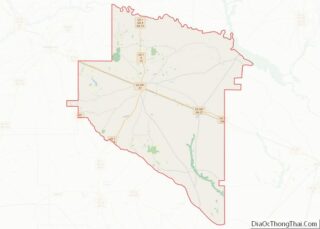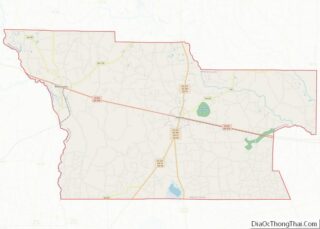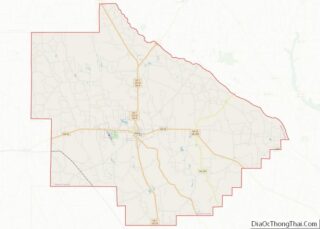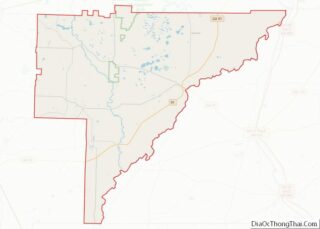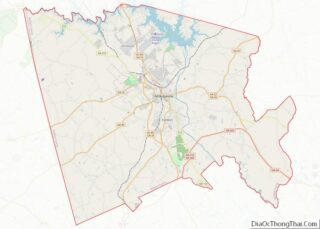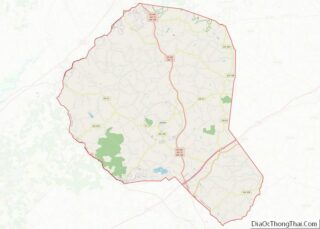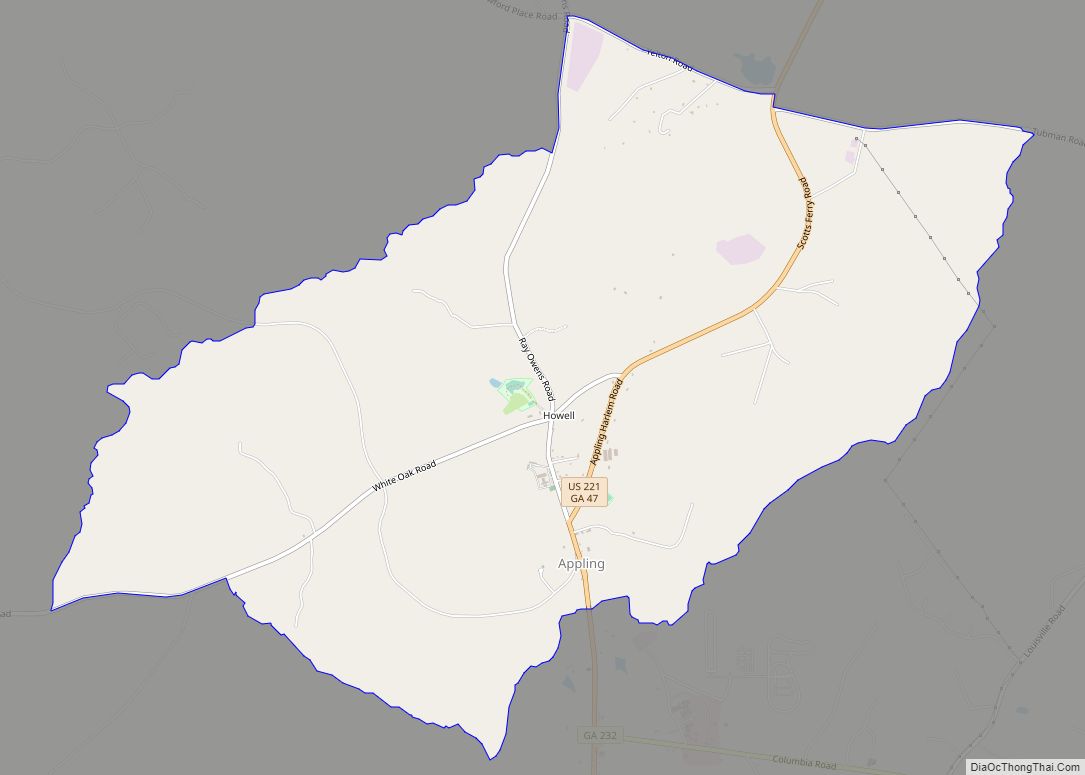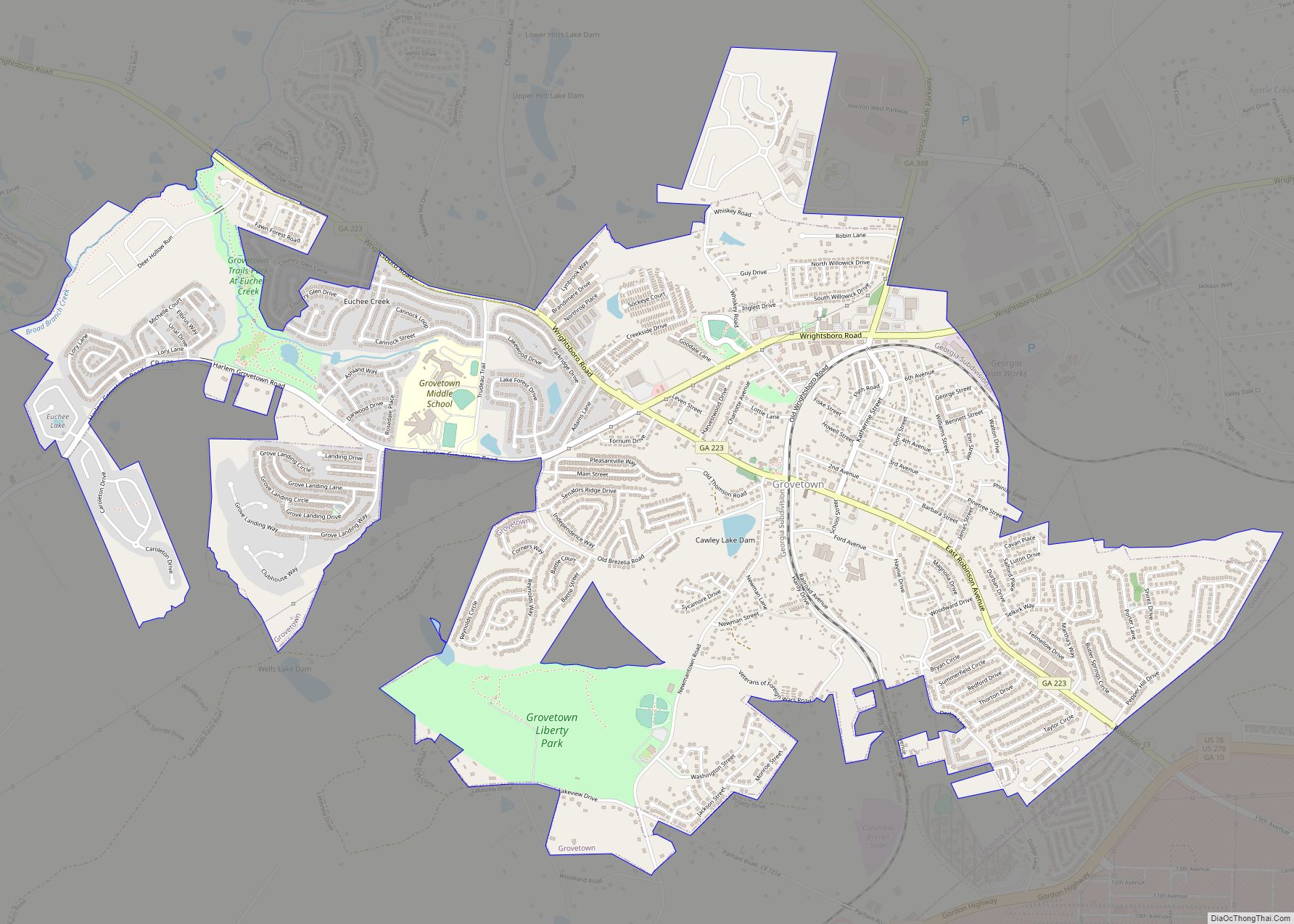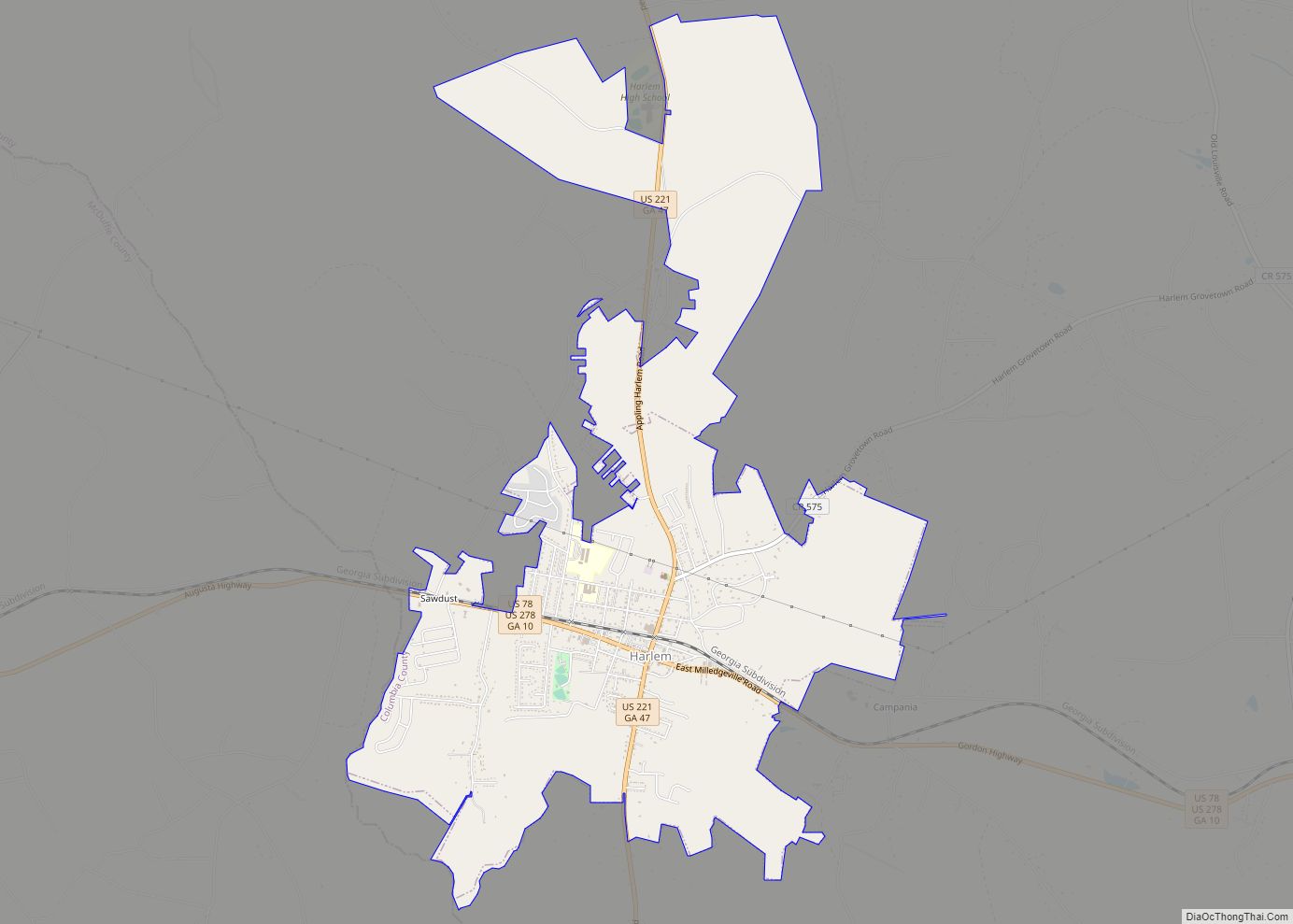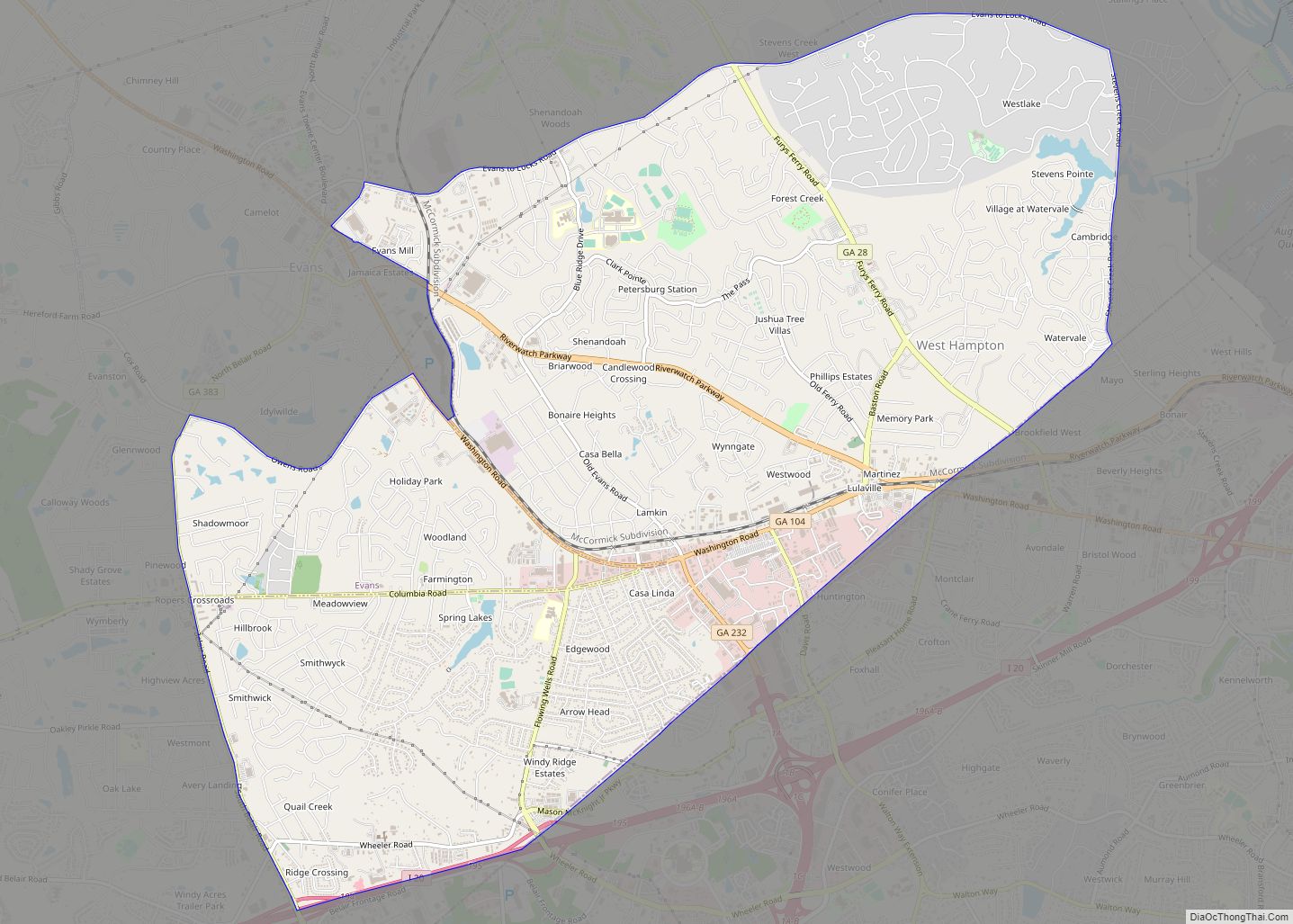Columbia County is a county located in the east central portion of the US state of Georgia. As of the 2020 census, the population was 124,035. The legal county seat is Appling, but the de facto seat of county government is Evans.
Columbia County is included in the Augusta-Richmond County, GA-SC Metropolitan Statistical Area. It is located along the Savannah River.
| Name: | Columbia County |
|---|---|
| FIPS code: | 13-073 |
| State: | Georgia |
| Founded: | 1790 |
| Named for: | Christopher Columbus |
| Seat: | Appling (de jure) Evans (de facto) |
| Total Area: | 308 sq mi (800 km²) |
| Land Area: | 290 sq mi (800 km²) |
| Total Population: | 156,010 |
| Population Density: | 538/sq mi (208/km²) |
| Time zone: | UTC−5 (Eastern) |
| Summer Time Zone (DST): | UTC−4 (EDT) |
| Website: | www.columbiacountyga.gov |
Columbia County location map. Where is Columbia County?
History
Columbia County, the 12th county formed in Georgia, was created by an act of the Legislature of Georgia on December 10, 1790 from Richmond County.
Prehistory and the colonial era
This area along the Savannah River had been inhabited for thousands of years by various cultures of indigenous peoples. The area had been home to the historic Muscogee-speaking Creek; Yuchi, people speaking a language isolate; and Iroquoian-speaking Cherokee for years prior to European colonization. The Yuchi had moved south from Tennessee because of pressure from the Cherokee, who continued to move into the Piedmont and soon dominated the Native American tribes. One of the oldest archaeological sites in the nation to contain pottery can be found on Stallings Island.
During the Colonial era, settlement of what would become Columbia County occurred primarily due to colonists settling at the second city in Georgia, Augusta, located on the Fall Line. When the British Province of Georgia became a crown colony in 1755 and was divided into parishes, the area around Augusta became St. Paul’s Parish. The primary areas of settlement were Augusta; Wrightsboro (a Quaker settlement named for James Wright, the royal governor); and Brownsborough, which was near the present-day location of North Columbia Elementary School.
Because the Church of England was the established church in the province, it was against the law for anyone to preach contrary to its doctrines. Influenced by the Great Awakening in New England, in 1772 Daniel Marshall established Kiokee Baptist Church, the first Baptist church in Georgia. The church was located below Brownsborough along the Kiokee Creek in present-day Appling. Born in Connecticut, Marshall had been raised as a Presbyterian. He had become a Baptist and preached in the Carolinas before coming to Georgia, where he was arrested. Baptist preachers and their converts continued to flourish, and in Virginia their influence helped shape the young James Madison’s ideas on religious freedom, which he incorporated into the new Constitution. Marshall later served in the militia during the American Revolutionary War. During the 19th century and the Second Great Awakening, the Baptists became well established in Georgia and other southern states. The Baptists offered congregational participation to slaves and approved them and free blacks as preachers, leading to the growth in black membership in the church.
American Revolutionary War
Two small battles occurred in what would become the County during the Revolutionary War between Patriot Militia and Tories; the area was then primarily frontier and loyalties were badly divided. Legend has it that a small band of Patriots sought refuge from marauding Tories at the County’s most dramatic geological feature, Heggie’s Rock. One of these fights occurred on September 11, 1781, between the forces of Elijah Clarke and a band of Tories and British Regular soldiers.
George Walton, the Virginia-born statesman who signed the Declaration of Independence, resided in what would become Columbia County, as did William Few and Abraham Baldwin. They were delegates to the Federal Convention that framed the United States Constitution.
Formation of Columbia County
Just before and immediately after the Revolution, numerous Virginians and North Carolinians migrated to the frontier of Georgia above Augusta, including the area around Brownsborough. After the Revolution, residents disagreed as to whether Augusta or Brownsborough should be the county seat of Richmond County. At the insistence of William Few, the county was partitioned. The new county formed from Richmond was named “Columbia” (for the origin of the name see Columbia); this did not end the controversy about location of the county seat. The citizens of Columbia County turned to arguing among themselves. Supporters built one courthouse in Brownsborough, and those of Cobbham built another. The courthouse at Cobbham was used; and Brownsborough in short order ceased to exist. In 1793, part of the County was taken, combined with part of Wilkes County, and formed into Warren County.
Around 1799, William Appling deeded a tract of land to the county for the purpose of building a courthouse. It was near Kiokee Creek and the Baptist Church which Marshall had founded. A courthouse was constructed, and served the county until around 1808. The small town that existed around the church and courthouse came to be known as “Columbia Courthouse.” In 1809, the Baptist congregation left the town and constructed a new meeting house (a building which survives) several miles away near the junction of Kiokee and Greenbrier creeks. That same year, construction began on a new courthouse, which was completed in 1812. In 1816, Columbia Courthouse was chartered as the Town of Appling, named for the Appling family who had donated the land to the county, and for Colonel John Appling, a local resident who died in a campaign against the Seminole.
Early 19th century
Appling was the political, educational, social, and religious center of the county. Near Appling were located Mt. Carmel Academy and Columbia Institute. Mt. Carmel Academy was run by the famous Southern educator, Moses Waddel; it was here that John C. Calhoun and William H. Crawford were educated. Columbia Institute was started by a certain gentleman going by the surname Bush; he was none other than the Bushnell of Revolutionary War submariner fame. During the Georgia Gold Rush of the 1820s, some successful prospecting and mining occurred in Columbia County.
The 1830s were a period of major infrastructure projects and the coming of the railroad. When the Georgia Railroad was established, the judges determined that having trains’ passing near Appling would disturb their proceedings; they insisted that the railway line that was built in the county from Atlanta to Augusta pass well below Appling. Construction of the Augusta Canal in the 1830s required Columbia County’s cooperation, as the beginning of the canal and the locks were within the county.
In 1855, the Courthouse in Appling received a major overhaul, and after the remodeling was complete, the building was in more or less its present form. Despite the extensive project, builders retained the shell of the 1809–1812 building.
American Civil War
Plantation agriculture based on slave labor was the major force of the economy in the county prior to the American Civil War. Cotton production had expanded dramatically after the invention of the cotton gin, which enabled the cultivation of short-staple cotton in the upland areas. Numerous vast plantations existed, the central houses of some of which still exist. Thousands of slaves were brought to the county for labor. At times the slave population outnumbered the free white population.
When Georgia seceded from the United States, George Walker Crawford, a native son of Columbia County, presided over the Secession Convention. He had previously been elected as the only Whig governor of the State. Men from the county served in several companies, among them the Hamilton Rangers and the Ramsey Guards, some in the 48th Georgia Volunteer Infantry Regiment, and some in the 22nd; almost all in Wright’s Brigade. The troops assembled in front of the courthouse, then boarded trains at the depots: Berzelia, Sawdust, Dearing, and Thomson. No fighting occurred in the County during the war; nor was it directly in General Sherman’s path. According to some family stories, some Union cavalry scouts or bummers entered the county. Near the war’s end, the remnants of the Confederate treasury were taken through Columbia County from Augusta to where the Chennault Raid occurred in neighboring Lincoln County.
The war took a heavy toll on the white male population of the county; a plaque behind the bench in the main Courtroom bears the names of Columbia County’s Confederate dead. During Reconstruction, the County was subject to military occupation. Because of significant Ku Klux Klan violence in the late 1860s, it was attached to a special district including Warren, Wilkes, and Oglethorpe counties. Additional Union forces were sent there to try to suppress the insurgents and their vigilante crimes against freedmen. They had been steadily reported by the Freedmen’s Bureau, whose reports included a mob lynching of a freedman in Appling in July 1866.
Late 19th century
The railroad brought increased trade and population to Thomson. In 1870, the part of Columbia County which included Thomson, Dearing, and Wrightsboro, the 12,000 acre settlement established in 1768 by Colonial Governor James Wright as a settlement for displaced Quakers from North Carolina, was combined with parts of Warren County to form McDuffie County—named after South Carolina‘s U.S. Senator: George McDuffie. Thomson became the county seat of the newly formed county.
During the 1870s, Appling suffered severe damage during a tornado. It never regained its former wealth and position in the county before the Civil War.
During Reconstruction, the legislature passed an act to establish a public school system for the first time. Like the rest of the state, the county developed segregated schools. The new communities of Harlem and Grovetown grew up. Harlem arose in the 1880s when a disgruntled railroad employee named Hicks, angered by saloons and Sabbath breaking in Sawdust, moved along the tracks one mile east and set up a rival town, complete with its own depot. Sawdust was eclipsed by Harlem, losing its depot and being absorbed by the newer town in the 1920s. The city was named after Harlem, New York. Grovetown, named for Grove Baptist Church, developed as a summer resort in the 1880s for wealthy Augustans.
20th century
The 20th century brought many changes to the county, with new technologies and modernization. In 1917, Harlem was badly damaged by fire. Bringing electricity to the county began. Men from Columbia County answered the call of duty and served in both World Wars. Prior to World War II, the County was still primarily agricultural; it had escaped the boll weevil infestation that destroyed cotton crops in Mississippi and other parts of the South. The US Army built Camp (later Fort) Gordon, taking over a large portion of Richmond County and parts of Columbia, McDuffie, and Jefferson. The Army’s keeping the fort after WWII created a new population and economic center for the county. During the 1950s, the Clarks Hill Dam was constructed, submerging considerable land in northern Columbia County under the new reservoir. It prompted new residential development around the lake.
Between 1950 and 1990, the population increased dramatically. Agriculture declined, as farmland was redeveloped as suburban housing and community centers for persons employed in Augusta. Numerous personnel stationed at Fort Gordon eventually settled in Columbia County. During the 1960s, the schools were integrated largely without incident under the leadership of Superintendent John Pierce Blanchard. The unincorporated communities of Martinez (formerly Lulaville, named after a Cuban doctor) and Evans (possibly named after Confederate General Clement A. Evans) became the population centers of the county, since they were located nearest to Augusta.
During the 1980s and 1990s and demographic shifts, Evans gradually became the de facto county seat, as the Columbia County Government Center and the Government Complex Addition were built there to serve the growing population in the county’s eastern areas. Court functions remained in Appling since Georgia state law required that superior court sessions must be held at the county seat and courthouse of each county at least twice a year. In 1998, the legislature changed the law to allow counties with unincorporated county seats to hold court sessions at annexes or satellite courthouses. With the 1993 passage of legislation requiring incorporated cities to provide at least three municipal services, Appling was not able to maintain its status as an incorporated city. (There was question as to whether it was ever incorporated.) Appling was one of 187 inactive cities in Georgia that lost its charter on June 1, 1995. Today it is nearly a dead town. Following these changes, the county proceeded to build an expansive Courthouse Annex in Evans, completed in 2001. Appling retains its status as de jure county seat, but all governmental functions are carried out in Evans.
Historic sites in Appling include the Courthouse and Jail, the Marshall Monument, and various places associated with Kiokee Baptist Church. Other sites in the county include Stevens Creek Dam and Canal Locks, the birthplace of the comedian Oliver Hardy in Harlem, and various cemeteries.
Columbia County Road Map
Geography
According to the U.S. Census Bureau, the county has a total area of 308 square miles (800 km), of which 290 square miles (750 km) is land and 18 square miles (47 km) (5.7%) is water. The county is located in the Piedmont region of the state just above the fall line of the eastern United States.
The southern three-quarters of Columbia County is located in the Middle Savannah River sub-basin of the Savannah River basin. A very small corner in the northeast of the county, west of Clarks Hill, is located in the Upper Savannah River sub-basin of the larger Savannah River basin. The northern portion of Columbia County, north of Appling, is located in the Little River sub-basin of the same Savannah River basin, while the southwestern corner of the county, south of Harlem, is located in the Brier Creek sub-basin of the Savannah River basin.
Adjacent counties
- Richmond County (southeast)
- McDuffie County (west)
- Lincoln County (northwest)
- McCormick County, South Carolina (north)
- Edgefield County, South Carolina (northeast)
Bodies of water
- Clarks Hill Lake (Strom Thurmond Lake)
- Savannah River
- Kiokee Creek
- Little Kiokee Creek
- Euchee Creek
- Steiner Creek
- Tudor Branch
- Greenbrier Creek
- Boggy Gut Creek
- Cobb Creek
- Crawford Creek
- Reed Creek
- Sandy Run Creek
Geological formations
- Heggie’s Rock
- Burks Mountain
- Mount Carmel
